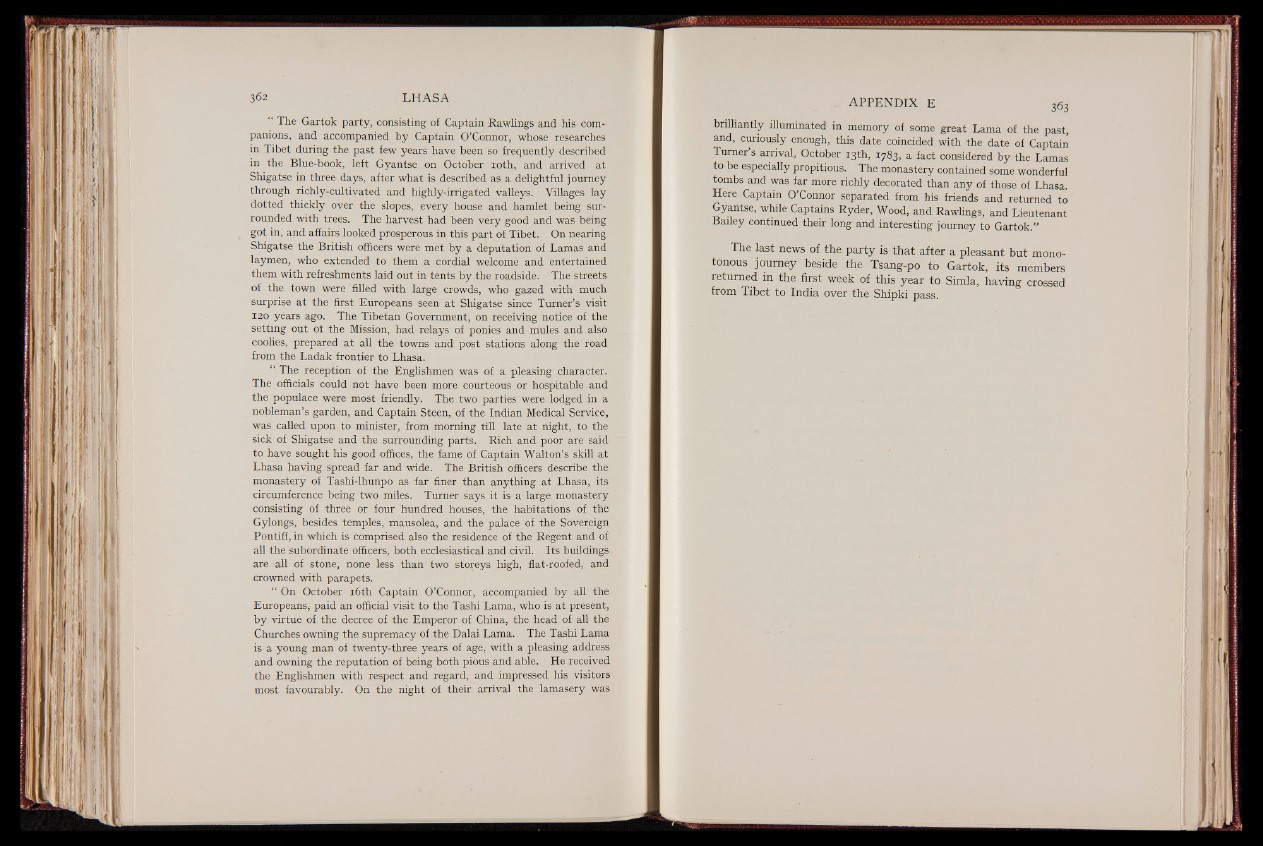
“ The Gartok party, consisting of Captain Rawlings and his companions,
and accompanied by Captain O’Connor, whose researches
in Tibet during the past few years have been so frequently described
in the Blue-book, left Gyantse on October ioth, and arrived at
Shigatse in three days, after what is described as a delightful journey
through richly-cultivated and highly-irrigated valleys. Villages lay
dotted thickly over the slopes, every house and hamlet being surrounded
with trees. The harvest had been very good and was being
got in, and affairs looked prosperous in this part of Tibet. On nearing
Shigatse the British officers were met by a deputation of Lamas and
laymen, who extended to them a cordial welcome and entertained
them with refreshments laid out in tents by the roadside. The streets
of the town were filled with large crowds, who gazed with much
surprise at the first Europeans seen at Shigatse since Turner’s visit
120 years ago. The Tibetan Government, on receiving notice of the
setting out of the Mission, had relays of ponies and mules and also
coolies, prepared at all the towns and post stations along the road
from the Ladak frontier to Lhasa.
“ The reception of the Englishmen was of a pleasing character.
The officials could not have been more courteous or hospitable and
the populace were most friendly. The two parties were lodged in a
nobleman’s garden, and Captain Steen, of the Indian Medical Service,
was called upon to minister, from morning till late at night, to the
sick of Shigatse and the surrounding parts. Rich and poor are said
to have sought his good offices, the fame of Captain Walton’s skill at
Lhasa having spread far and wide. The British officers describe the
monastery of Tashi-lhunpo as far finer than anything at Lhasa, its
circumference being two miles. Turner says it is a large monastery
consisting of three or four hundred houses, the habitations of the
Gylongs, besides temples, mausolea, and the palace of the Sovereign
Pontiff, in which is comprised also the residence of the Regent and of
all the subordinate officers, both ecclesiastical and civil. Its buildings
are all of stone, none less than two storeys high, flat-roofed, and
crowned with parapets.
“ On October 16th Captain O’Connor, accompanied by all the
Europeans, paid an official visit to the Tashi Lama, who is at present,
by virtue of the decree of the Emperor of China, the head of all the
Churches owning the supremacy of the Dalai Lama. The Tashi Lama
is a young man of twenty-three years of age, with a pleasing address
and owning the reputation of being both pious and able. He received
the Englishmen with respect and regard, and impressed his visitors
most favourably. On the night of their arrival the lamasery was
brilliantly illuminated in memory of some great Lama of the past,
and, curiously enough, this date coincided with the date of Captain
Turner s arrival, October 13th, 1783, a fact considered by the Lamas
to be especially propitious. The monastery contained some wonderful
tombs and was far more richly decorated than any of those of T.W?
Here Captain O’Connor separated from his friends and returned to
Gyantse, while Captains Ryder, Wood, and Rawlings, and Lieutenant
Bailey continued their long and interesting journey to Gartok.”
The last news of the party is that after a pleasant but monotonous
journey beside the Tsang-po to Gartok, its members
returned m the first week of this year to Simla, having crossed
from Tibet to India over the Shipki pass.